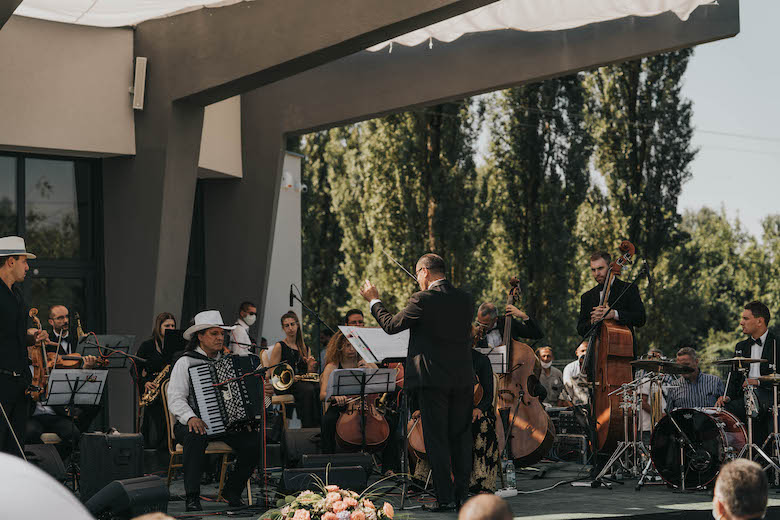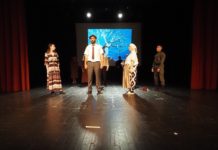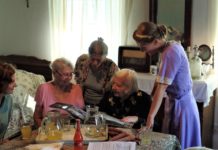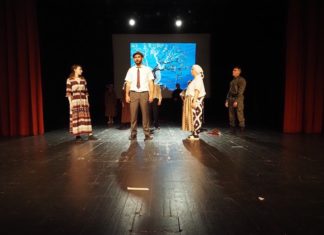This year’s commemoration for the Rromani victims, nearby the former concentration camp, in the village of Uštica near Jasenovac, which took place on August 2, was attended by significantly fewer Rroma than in previous years. The number of visitors was limited due to measures prescribed to combat the coronavirus pandemic, so instead of 2,000 visitors, as in previous years, this year about five hundred participated, along with representatives of Croatian state and social institutions. This year’s program was enriched by the grand opening of the Rroma Memorial Centre, the world’s only museum space dedicated to the genocide of the Rroma during World War II. It was built on a Rroma cemetery that covers a surface space of 4,292 square metres with 21 mass graves of a total area of 1,218 square metres, in which the deported and killed Rroma were buried during the Independent State of Croatia from 1942 to 1945.
The small village of Uštica was founded at the end of the 18th century and was inhabited by Croats and Serbs. In May 1942, the entire Serbian population of Uštica, together with Serbs from the surrounding areas, was taken to the Jasenovac camp, and their confiscated property was used to house the first groups of deported Rroma. Thus, the so-called “Gypsy camp” was established, which was in function for three years, and was closed only in May 1945 after the arrival of the People’s Liberation Army. According to the official census of the Jasenovac Memorial Site Public Institution (JUSP Jasenovac), during that period in the Uštica camp and in the Donja Gradina camp, which was part of the same system of concentration camps located across the Jasenovac camp at the mouth of the Una and Sava Rivers, 16 173 Rroma men and women were killed. These data listed in the List of Individual Victims of the Jasenovac Concentration Camp are the only data we can hold on to more or less firmly, points out the curator of the newly opened Rroma Memorial Centre, Sunčica Habus Nagradić and adds: Some try to reduce this number, others believe that it is even greater, but any further discussion is possible only after the conduct of new systematic scientific research. The pre-war and post-war censuses also testify to the large number of missing members of the Rroma people during the war. According to the 1931 census, there were between 14,000 and 15,000 Rroma men and women in Croatia, and the 1948 census reported the number of only 405. Unlike the German Nazi camps, the Ustashas did not keep accurate records of every prisoner, and especially not for the Rroma. They were “counted” only by the number of overcrowded wagons that brought them to Uštica village.
Rroma in Croatia, as well as the interested Rroma public throughout Europe and the world, followed with interest the construction of the Rroma Memorial Centre. Numerous representatives of the Croatian County and City Councils of the Rroma national minority, who witnessed the construction in its the final stages before the opening ceremony, were evidently touched and full of emotion and agreed that the Rroma victims were finally recognized and would not be forgotten. When I arrived to Uštica and saw the Rroma Memorial Centre, my eyes filled with tears. My grandmother, along with other Rroma from Međimurje, was deported to a camp, not this one in Uštica, but to the Komárom camp in Hungary, and I was always afraid that her memories would fade in the minds of my Rroma people with each new generation, but this Memorial Centre will rescue the tragic story of the Rroma people from oblivion, said Matjaš Oršuš, President of the Council of the Rroma National Minority of Međimurje County.
Participation of the Greater Europe Peace Orchestra leader, Santino Spinelli, who came from Italy with his symphony orchestra to celebrate this solemn commemoration, represented a tremendous honour for the opening of the Rroma Memorial Centre Uštica. As a particularly important role of the Museum, he pointed out the fact that the permanent museum exhibition will forever inscribe in European history the truth about the Rroma occurrences: No one will be able to say that it did not exist or that they did not know about Samudaripen. To tell the story of people who disappeared, about people whose fate is little known in Croatia, but also around the world, and to bring historical facts to a wide circle of people is the original motivation and task of curator Habus Nagradić. The job of a curator in this Museum represents, in addition to great pleasure, a special professional challenge for her: Creating museum’s permanent exhibition represents a curator’s career highlight and many of my colleagues do not get such an opportunity throughout their careers.

The conceptual design of the permanent museum exhibition arose from joint cooperation with historians who set this historical period on a solid scientific foundation, and after that established the implementation solution with concrete elements that needed to be spatially realized. We are currently in this second phase. Danijel Vojak, PhD historian and professor of history from the Institute of Social Sciences Ivo Pilar, has dedicated his long-term scientific work to researching the history of the Rroma and their suffering in World War II, and my task is to balance these historical facts with concrete implementation solutions which would reach as many people as possible, a wide spectrum of generations, from elementary school pupils to retirees, explained Sunčica Habus Nagradić. Furthermore, the size of the exhibition space of about 300 square meters should be taken into account, in which a complex, delicate and large area should be conceptually located, which is certainly another challenge, she added. The permanent exhibition will cover several thematic units: the immigration of Rroma to Croatia in the 14th and 15th centuries, the position of the Rroma between the two world wars, which shows that what happened to the Rroma during the Independent State of Croatia was actually an escalation of the previous situation, broader context of European events marked by the Second World War and Nazi policy, the fate of Rroma in neighbouring countries and, finally, the very core of the Museum, and that is the camp in Uštica village – deportation of Rroma to Uštica, treatment, liquidation and mass graves.
The Uštica site was opened in 1971, when a memorial plaque was erected, and in journalistic articles from that year, the tombs found were described as monster tombs and the exact dimensions of each were stated. Further organisation of this place of remembrance was planned, but over the years its maintenance ceased and it remained neglected until 2012, when Rromani non-governmental organizations held the first commemoration of Samudaripen there. Since then, at the initiative of the Croatian Rromani Union “KALI SARA”, intensive work had begun organising this part of the Jasenovac Memorial Site, and in 2019 a coordinated process of building a Rroma Memorial Centre was initiated through MP Veljko Kajtazi, the City of Zagreb and the Government.
During the opening of the Centre, visitors had the opportunity to tour the exhibition “Genocide against the Rroma in the Independent State of Croatia from 1941 to 1945” by Danijel Vojak, PhD and curator Sunčica Habus Nagradić. They have set a one-year deadline for the permanent exhibition to be finished, planning it for January 2021, although, as the curator told us, it is not uncommon for the permanent exhibition to take several years. She also shared with us what they focus on in their work: Since relatively few museum objects have been preserved, such as personal belongings of detainees, we will base the exhibition on audio-visual materials, such as archival photographs, videos and the like, because we have a lot of such materials. . Also, in line with museum trends, we are working on the digitization of the heritage, but I try to find a balance between classic media (photographs and printed materials) and multimedia, partly because a large proportion of our visitors are elderly, but also because looking at the screen emotionally distances people.
“The world is full of powers, but nothing is more powerful than man,” are the words written on a memorial plaque at the Rroma cemetery in Uštica village; because man’s true strength comes from their ability to empathize with other human beings. No matter how strong the fear of others and different, which made people commit horrible crimes; mind and heart filled with love are much stronger. We need to learn from history so as not to repeat the same mistakes, but we need to focus on the present to make the world a better place. Such a message is expressed in the verses of the Rromani poem Auschwitz: Do not plant flowers in the Auschwitz Camp, saturate the world with love, recited by their author Santino Spinelli accompanied by the European Peace Orchestra at this solemn commemoration.












